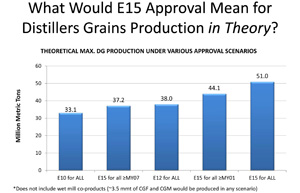Hitting the Feed Wall

November 15, 2010
BY Holly Jessen
If concerns about a blend wall aren't enough, U.S. ethanol producers should also keep their collective eye on a rapidly approaching feed wall.
In the 2010-'11 marketing year, U.S. dry mill ethanol plants are expected to produce 33.5 million metric tons of wet and dry distillers grains, according to Bob Dinneen, president and CEO of the Renewable Fuels Association. Wet mills will produce another 3 million metric tons of corn gluten feed and 500,000 metric tons of corn gluten meal.
If it weren't for the distillers grains export market, those production numbers would be a problem. The U.S. livestock feed market will likely reach saturation with distillers grains when the industry produces 35 to 45 million metric tons. "You have heard talk of the ethanol blend wall that limits the amount of ethanol that can be used," Dinneen said. "In much the same manner, we are rapidly approaching a feed wall in the U.S."
Dinneen tackled the subject at the Export Exchange, held Oct. 6-8 in Chicago. The joint conference put on by RFA and the U.S. Grains Council attracted nearly 500 producers, suppliers, importers and end-users of U.S. distillers grains and coarse grains. In the long term, he told attendees, distillers grains export growth will allow the industry to grow profitably, maintaining demand and prices and diversifying the customer base. Of the 33.5 million metric tons of distillers grains expected to be produced this year, 24.5 million will be consumed domestically and 9 million metric tons will be exported.
If E15 is approved, ethanol producers could, theoretically, produce more ethanol—and distillers grains. Not including wet mill products, Dinneen said E15 approval would raise distillers grains production to a maximum 51 million metric tons. However, if the U.S. EPA approves E15 for only certain model years, the impact will be less. Dinneen emphasized these maximums were theoretical, as discussions with fuel retailers suggest that the market share would be much lower.
Finding new markets for distillers grains is vital, Dinneen stressed. "Ethanol production is fuel and feed. It is not either/or. And the success of one has a great impact on the viability of the other."
In related news, a subcommittee of the International Maritime Organization in London approved a U.S. proposal that distillers grains be classified as nonhazardous cargo. The decision is expected to be ratified when the committee meets in December and will become binding in 2013. "This is a major step toward resolving confusion that has emerged about shipping requirements for DDGS," said Erick Erickson, U.S. Grains Council special assistant for planning, evaluation and projects.
In the 2010-'11 marketing year, U.S. dry mill ethanol plants are expected to produce 33.5 million metric tons of wet and dry distillers grains, according to Bob Dinneen, president and CEO of the Renewable Fuels Association. Wet mills will produce another 3 million metric tons of corn gluten feed and 500,000 metric tons of corn gluten meal.
If it weren't for the distillers grains export market, those production numbers would be a problem. The U.S. livestock feed market will likely reach saturation with distillers grains when the industry produces 35 to 45 million metric tons. "You have heard talk of the ethanol blend wall that limits the amount of ethanol that can be used," Dinneen said. "In much the same manner, we are rapidly approaching a feed wall in the U.S."
Dinneen tackled the subject at the Export Exchange, held Oct. 6-8 in Chicago. The joint conference put on by RFA and the U.S. Grains Council attracted nearly 500 producers, suppliers, importers and end-users of U.S. distillers grains and coarse grains. In the long term, he told attendees, distillers grains export growth will allow the industry to grow profitably, maintaining demand and prices and diversifying the customer base. Of the 33.5 million metric tons of distillers grains expected to be produced this year, 24.5 million will be consumed domestically and 9 million metric tons will be exported.
If E15 is approved, ethanol producers could, theoretically, produce more ethanol—and distillers grains. Not including wet mill products, Dinneen said E15 approval would raise distillers grains production to a maximum 51 million metric tons. However, if the U.S. EPA approves E15 for only certain model years, the impact will be less. Dinneen emphasized these maximums were theoretical, as discussions with fuel retailers suggest that the market share would be much lower.
Finding new markets for distillers grains is vital, Dinneen stressed. "Ethanol production is fuel and feed. It is not either/or. And the success of one has a great impact on the viability of the other."
In related news, a subcommittee of the International Maritime Organization in London approved a U.S. proposal that distillers grains be classified as nonhazardous cargo. The decision is expected to be ratified when the committee meets in December and will become binding in 2013. "This is a major step toward resolving confusion that has emerged about shipping requirements for DDGS," said Erick Erickson, U.S. Grains Council special assistant for planning, evaluation and projects.
Advertisement
Advertisement
Advertisement
Advertisement
Upcoming Events





